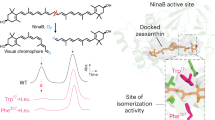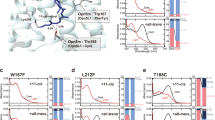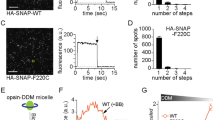Abstract
CYCLOPHILINS are ubiquitous and abundant proteins that exhibit peptidyl prolyl cis-trans isomerization (PPlase) activity in vitro1,2. Their functions in vivo, however, are not well understood. Two new retinal cyclophilin isoforms, types I and II, are highly expressed in cone photoreceptors of the vertebrate retina3. Type-II cyclophilin is identical to RanBP2, a large protein that binds the GTPase Ran4,5. Here we report that two contiguous domains in RanBP2, Ran-binding domain 4 (RBD4) and cyclophilin, act in concert as a chaperone for the opsin molecule of the red/green-sensitive visual pigment of a dichromatic vertebrate. In Drosophila, the cyclophilin NinaA6,7 is expressed in all photoreceptors8 and is required for the expression of only a subset of opsins8,9. The molecular basis of these photoreceptor class-specific effects and the functions of NinaA and other cyclophilins in vivo remain unclear10. Unlike NinaA, which forms a stable complex with opsin from retinular cells Rl–611, we find that the cyclophilin domain of RanBP2 does not bind opsin directly; rather, it augments and stabilizes the interaction between red/green (R/G) opsin and the RBD4 domain. This involves a cyclophilin-mediated modification of R/G opsin, possibly involving proline isomerization. The RBD4–cyclophilin supradomain of RanBP2, therefore, is a form of vertebrate chaperone of defined substrate specificity, which may be involved in the processing and/or transport of long-wavelength opsin in cone photoreceptor cells.
This is a preview of subscription content, access via your institution
Access options
Subscribe to this journal
Receive 51 print issues and online access
$199.00 per year
only $3.90 per issue
Buy this article
- Purchase on Springer Link
- Instant access to full article PDF
Prices may be subject to local taxes which are calculated during checkout
Similar content being viewed by others
References
Fisher, G., Wittmann-Liebold, B., Lang, K., Kiefhaber, T. & Schmid, F. Nature 337, 476–478 (1989).
Bergsma, D. et al. J. Biol. Chem. 266, 23204–23214 (1991).
Ferreira, P., Hom, J. & Pak, W. J. Biol. Chem. 270, 23179–23188 (1995).
Yokoyama, N. et al. Nature 376, 184–188 (1995).
Wu, J., Manutis, M., Kraemer, D., Blobel, G. & Coutavas, E. J. Biol. Chem. 270, 14209–14213 (1995).
Schneuwly, S. et al. Proc. Natl Acad. Sci. USA 86, 5390–5394 (1989).
Shieh, B.-H., Stammes, M., Seavello, S., Harris, G. & Zuker, C. Nature 338, 67–70 (1989).
Stamnes, A., Shieh, B.-H., Chuman, L., Harris, L. & Zuker, C. Cell 65, 219–227 (1991).
Larrivee, D., Conrad, S., Stepheson, R. & Pak, W. J. Gen. Physiol. 78, 521–545 (1981).
Ferreira, P. & Pak, W. In Degenerative Diseases of the Retina (eds Angerson, ?, La Vail, ? & Hollyfield, ?) 263–274 (Plenum, New York, 1995).
Baker, E., Colley, N. & Zuker, C. EMBO J. 13, 4886–4895 (1994).
Wang, Y. et al. Neuron 9, 429–440 (1992).
Nathans, J., Thomas, D. & Hogness, D. Science 232, 193–202 (1986).
Nathans, J. & Hogness, D. Cell 34, 807–814 (1983).
Travis, G., Sutcliffe, J. & Bok, D. Neuron 6, 61–70 (1991).
Zydowsky, L. et al. Protein Sci. 1, 1092–1099 (1992).
Kallen, H. & Walkinshaw, M. FEBS Lett. 300, 286–290 (1992).
Ke, H., Mayrose, D. & Cao, W. Proc. Natl Acad. Sci. USA 90, 3324–3328 (1993).
Kamps, K., De Grip, W. & Daemen, F. Biochim. Biophys. Acta 687, 296–302 (1982).
Walter, A., Shuster, T. & Farber, D. Invest. Ophthalmol. Vis. Sci. 27, 1609–1614 (1986).
Stephenson, R. S., O'Tousa, J., Scavarda, N. J., Randall, L. L. & Pak, W. L. in The Biology of Photoreception (eds Cosens, D. J. & Vince-Price, D.) 447–501 (Cambridge Univ. Press, 1983).
Pak, W. L. Invest. Ophthalmol. Vis. Sci. 36, 2340–2357 (1995).
Molday, R. S. & Molday, L. L. J. Cell Biol. 105, 2598–2601 (1987).
Schlenstedt, G., Saavedra, C., Loeb, J., Cole, C. & Silver, P. Proc. Natl Acad. Sci. USA 92, 225–229 (1995).
Ren, M. et al. Mol. Cell. Biol. 15, 2117–2124 (1995).
Klebe, C., Bischoff, F. R., Ponstingl, H. & Wittinghofer, A. Biochemistry 34, 639–647 (1995).
Roepman, R. et al. Hum. Mol. Genet. 5, 827–833 (1996).
Roepman, R. et al. Hum. Mol. Genet. 5, 1035–1041 (1996).
Meindl, A. et al. Nature Genet. 13, 35–42 (1992).
Nakayama, T. A. & Khorana, H. G. J. Biol. Chem. 266, 4269–4275 (1991).
Author information
Authors and Affiliations
Rights and permissions
About this article
Cite this article
Ferreira, P., Nakayama, T., Pak, W. et al. Cyclophilin-related protein RanBP2 acts as chaperone for red/green opsin. Nature 383, 637–640 (1996). https://doi.org/10.1038/383637a0
Received:
Accepted:
Issue Date:
DOI: https://doi.org/10.1038/383637a0
This article is cited by
-
Characterization and regulation of salt upregulated cyclophilin from a halotolerant strain of Penicillium oxalicum
Scientific Reports (2023)
-
The Bursaphelenchus xylophilus effector BxML1 targets the cyclophilin protein (CyP) to promote parasitism and virulence in pine
BMC Plant Biology (2022)
-
Cyclophilin anaCyp40 regulates photosystem assembly and phycobilisome association in a cyanobacterium
Nature Communications (2022)
-
ER complex proteins are required for rhodopsin biosynthesis and photoreceptor survival in Drosophila and mice
Cell Death & Differentiation (2020)
-
The coming-of-age of nucleocytoplasmic transport in motor neuron disease and neurodegeneration
Cellular and Molecular Life Sciences (2019)
Comments
By submitting a comment you agree to abide by our Terms and Community Guidelines. If you find something abusive or that does not comply with our terms or guidelines please flag it as inappropriate.



